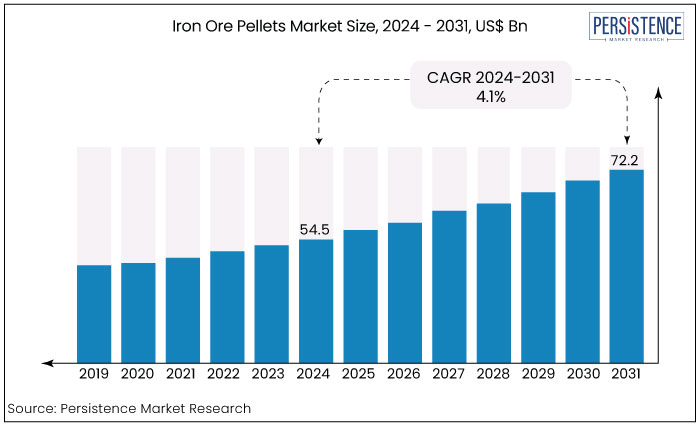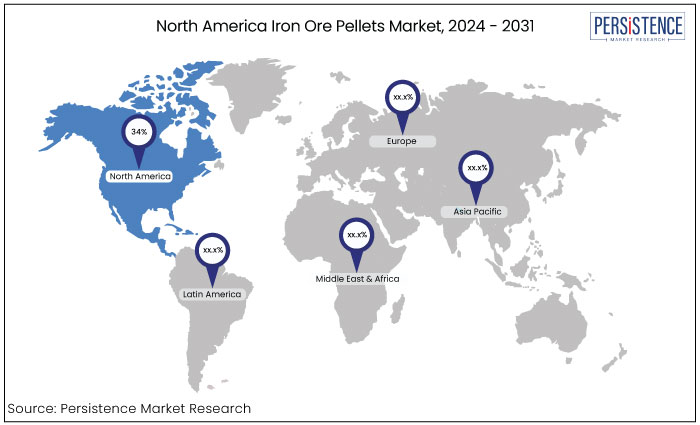Industry: Chemicals and Materials
Published Date: September-2024
Format: PPT*, PDF, EXCEL
Delivery Timelines: Contact Sales
Number of Pages: 163
Report ID: PMRREP31356
The iron ore pellets market is estimated to increase from US$54.5 Bn in 2024 to US$72.2 Bn by 2031. The market is projected to record a CAGR of 4.1% during the forecast period from 2024 to 2031. The growing demand for high-grade pellets owing to the low-carbon steelmaking drives the market forward. North America region accumulates the largest market share owing to the robust industrialization in the region.

Key Highlights of the Market
|
Market Attributes |
Key Insights |
|
Iron Ore Pellets Market Size (2024E) |
US$54.5 Bn |
|
Projected Market Value (2031F) |
US$72.2 Bn |
|
Global Market Growth Rate (CAGR 2024 to 2031) |
4.1% |
|
Historical Market Growth Rate (CAGR 2019 to 2023) |
3.8% |
|
Region |
Market Share in 2024 |
|
North America |
34% |
North America is anticipated to exhibit the high growth rate throughout the projection period. Regional market growth is due to the strong demand from the construction, aerospace, defence, and automotive industries.
It is anticipated that the demand for steel will be driven by the resurrection of aircraft manufacturing operations in addition to the growing production of electric vehicles (EVs) in the region. It is anticipated that this will increase the demand for pellets in the years to come.
The market for iron ore pellets in the United States held the large revenue share. The rise in the production of steel and the movement toward more environmentally responsible manufacturing techniques are both factors that have contributed to the expansion of the product market.
The market in the United States is expanding as a result of shifting trends toward carbon-less steelmaking. Steel demand is anticipated to be driven by rising electric vehicle production and the revival of aircraft manufacturing industries. As a consequence of this, the demand for iron ore pellets is projected to increase over the forecast period.

|
Category |
Market Share in 2024 |
|
Product - Blast Furnace |
56% |
The iron ore pellets market is segmented into blast furnace and direct reduced furnace based on product. Among these, the blast furnace segment dominates the market. The products utilized in the BF method are of inferior quality relative to those employed in the direct reduced (DR) approach. Consequently, they are more economical than their equivalents. Integrated steel plants often employ the blast furnace technique.
The reduced expense of these pellets coupled with the prevalence of integrated steel mills in developed nations is the principal reason for propelling expansion in the BF market.
|
Category |
Market Share in 2024 |
|
Trade - Captive |
60% |
The market for iron ore pellets is divided into captive and seaborne. Among these, the captive trade segment dominates the market based on trade. The captive trade sector is estimated to lead the market in 2024 in terms of market share. Iron ore pellets are utilized for internal production or delivered to proximate clients for steel fabrication.
Global steel production is influenced by leading steel corporations such as ArcelorMittal, which plays a vital role in sourcing their iron ore pellets from their production plan further solidifying their position in the industry.
Iron ore pellets are a crucial raw material utilized by the steel industry in steel manufacturing. Iron ore pellets facilitate the swift growth of the steel industry and contribute to the stability of the global economy.
The predicted expansion of the iron ore pellets market during the forecast period is attributed to increasing product demand from the steel sector, expanding commercial and residential construction projects, and various sports construction activities. Advancements observed in manufacturing processes are projected to further stimulate the market during the forecast period.
The market research provides a comprehensive analysis of the global and regional markets including an evaluation of market attractiveness with all segments assessed according to their growth rate, overall appeal, and market size.
The steel industry is a significant consumer of iron ore pellets. Manufacturers sell pellets to the steel sector via contractual agreements. The expansion of the steel industry serves as a principal catalyst for the advancement of the global iron ore pellets market.
The iron ore pellet market experienced steady growth pre-2023 driven by increasing demand from the steel industry particularly in emerging markets such as China and India. Pellets have high iron content and are preferred for blast furnaces due to their lower impurities and energy efficiency.
The growing focus on reducing carbon emissions in steel production coupled with government initiatives encouraging clean production methods contributed to the demand for high-quality pellets over sinter and lump ores.
Post-2024, the market is projected to expand at a significant rate due to several factors. A key driver is the global push toward decarbonization especially in industries like steel manufacturing. Demand is expected to surge with the rise of electric arc furnaces (EAFs), which utilize scrap and high-quality raw materials like iron ore pellets.
The increasing adoption of green hydrogen-based steel production further supports this trend. Supply chain optimization and advancements in pelletizing technologies are anticipated to enhance production capacity, reduce costs, and boost market growth. Asia Pacific region, particularly India is poised for significant growth as investments in steel infrastructure projects rise.
Decarbonization of Steel Production
One of the key growth drivers for the iron ore pellet market is the global shift toward reducing carbon emissions in the steel industry. Traditional blast furnaces which rely on raw iron ore and coke emit high levels of CO2.
Iron ore pellets with their high iron content and lower impurities are preferred in more energy-efficient production processes like Direct Reduced Iron (DRI) and Electric Arc Furnaces (EAF). These methods contribute to lower greenhouse gas emissions.
Governments and industries particularly in Europe and North America are pushing for strict environmental regulations and incentivizing the adoption of low-carbon technologies boosting the demand for pellets over traditional sintered ores.
The potential use of green hydrogen in steel production, which requires high-quality iron inputs such as pellets is expected to further drive market demand as the industry moves toward green, and more sustainable practices.
Expansion of the Global Steel Industry
The continuous expansion of the global steel industry particularly in emerging markets like India, China, and Southeast Asia is another key driver for the iron ore pellet market. Iron ore pellets are vital raw materials in steel production. As these regions focus on urbanization, infrastructure development, and industrial growth, the demand for steel and by extension iron ore pellets is rising.
Countries like India are making significant investments in infrastructure, construction, and automotive industries, all of which require large quantities of steel. Iron ore pellet manufacturers are ramping up production to meet the growing demand supported by technological advancements in pelletizing processes, which enhance efficiency and output.
Asia Pacific region home to some of the world’s largest steel producers and is expected to be a key driver for pellet market growth with government-backed projects and expanding industrial sectors playing a crucial role.
Volatility in Iron Ore Prices
One of the significant restraints for the iron ore pellets market is the fluctuation in iron ore prices. Several factors including changes in demand from steel manufacturers, geopolitical tensions, and supply chain disruptions influence iron ore pricing.
Disruptions in major iron ore-producing regions like Brazil and Australia due to environmental factors or political instability can lead to price spikes. These fluctuations affect pellet manufacturers' profitability and production planning.
The high iron ore prices may compel steel manufacturers to seek alternative raw materials such as scrap metal or lower-cost sintered ores reducing demand for pellets. The price volatility creates uncertainty in long-term contracts and investments in pelletizing facilities restraining the market growth especially in regions with tight profit margins.
Adoption of Green Steel and Hydrogen-based Production
One of the most transformative opportunities in the iron ore pellet market is the growing focus on "green steel" production driven by the need to decarbonize the steel industry. Traditional steelmaking processes are carbon-intensive, but the use of hydrogen in place of coal to reduce iron ore is gaining traction.
Hydrogen-based steel production methods such as the use of Direct Reduced Iron (DRI) with green hydrogen require high-quality iron ore pellets to ensure efficient reduction and high-grade steel output. This shift presents a significant opportunity for pellet producers to cater to the emerging green steel industry.
As global policies and corporate sustainability goals increasingly favour low-carbon steel production, the demand for these specialized pellets is expected to rise. The growing demand is especially observed in regions like Europe and North America, which are at the forefront of the green steel transition.
Technological Advancements in Pellet Production
The ongoing advancements in pelletizing technology offer another transformative opportunity for the iron ore pellets market. Innovations such as energy-efficient pelletizing processes, improved binders, and the ability to process lower-grade ores are reshaping the industry. These advancements reduce the environmental footprint of pellet production and lower operational costs.
Pellet manufacturers can use these technologies to increase production efficiency, reduce emissions, and produce higher-quality pellets catering to traditional steelmakers and the emerging green steel market. Adapting these technological improvements will maintain a competitive edge as demand for premium-grade pellets grows globally.
The competitive landscape of the iron ore pellets market is dominated by a few key players, including Vale S.A., Rio Tinto, BHP Group, and Cleveland-Cliffs. These companies hold substantial market share due to their extensive mining operations, advanced pelletizing technologies, and strong global distribution networks. These companies benefit from vertical integration controlling both mining and pellet production, which ensures supply chain stability and cost efficiency.
Emerging players in regions like India and Southeast Asia are gaining traction due to rising steel production in these areas. Competitive differentiation is increasingly driven by innovation in pellet quality, sustainability practices, and the ability to cater to the growing demand for low-carbon, high-grade pellets for green steel production. Strategic partnerships and capacity expansions are key growth strategies.
Recent Industry Developments in the Iron Ore Pellets Market
|
Attributes |
Details |
|
Forecast Period |
2024 to 2031 |
|
Historical Data Available for |
2019 to 2023 |
|
Market Analysis |
US$ Billion for Value |
|
Key Regions Covered |
|
|
Key Market Segments Covered |
|
|
Key Companies Profiled in the Report |
|
|
Report Coverage |
|
|
Customization & Pricing |
Available upon request |
By Product
By Trade
By Region
To know more about delivery timeline for this report Contact Sales

The market is estimated to be valued at US$72.2 Bn by 2031.
The market is projected to exhibit a CAGR of 4.1% over the forecast period.
A few of the key players operating in the market are ArcelorMittal, Bahrain Steel, and Cleveland-Cliffs.
The expansion of the global steel industry drives the market forward.
North America dominates the market for iron ore pellets.